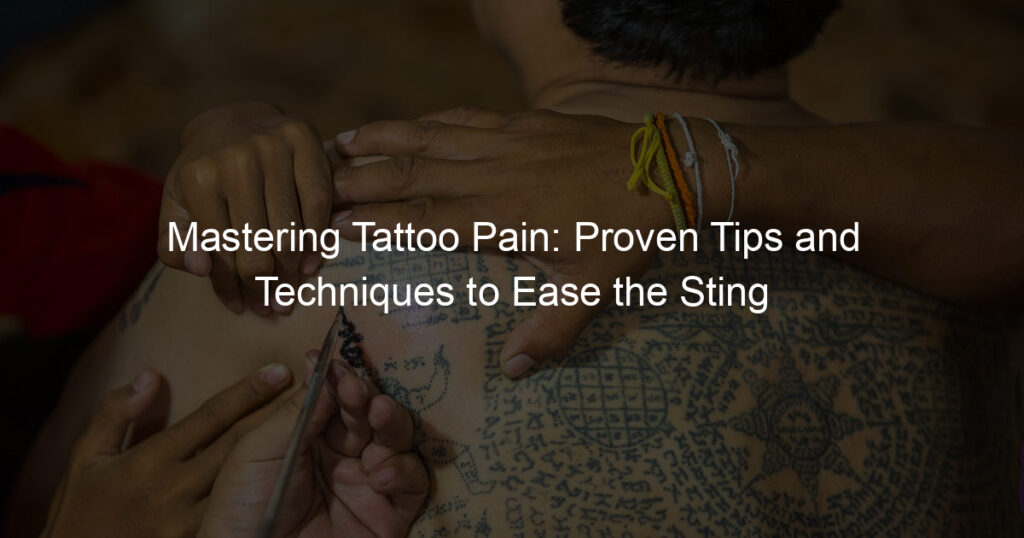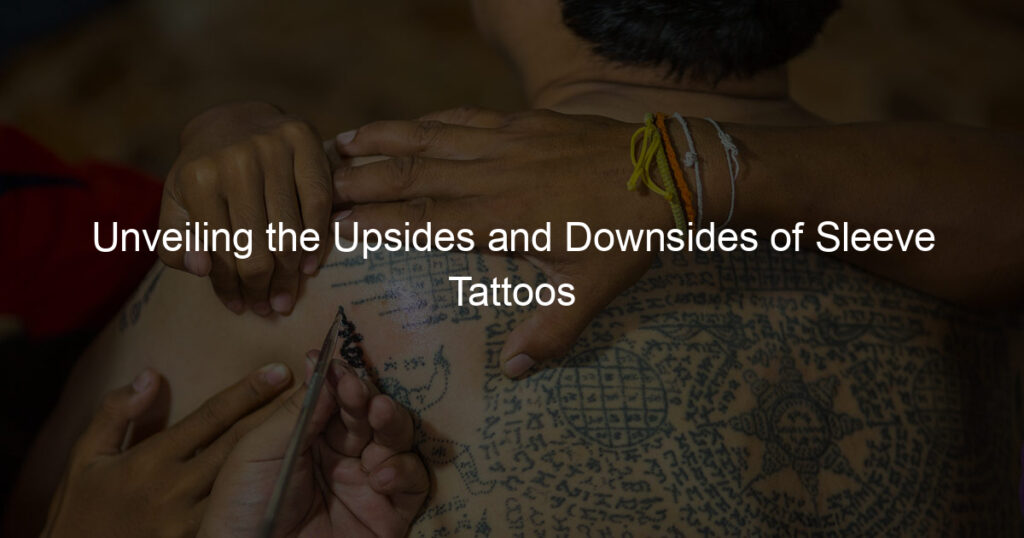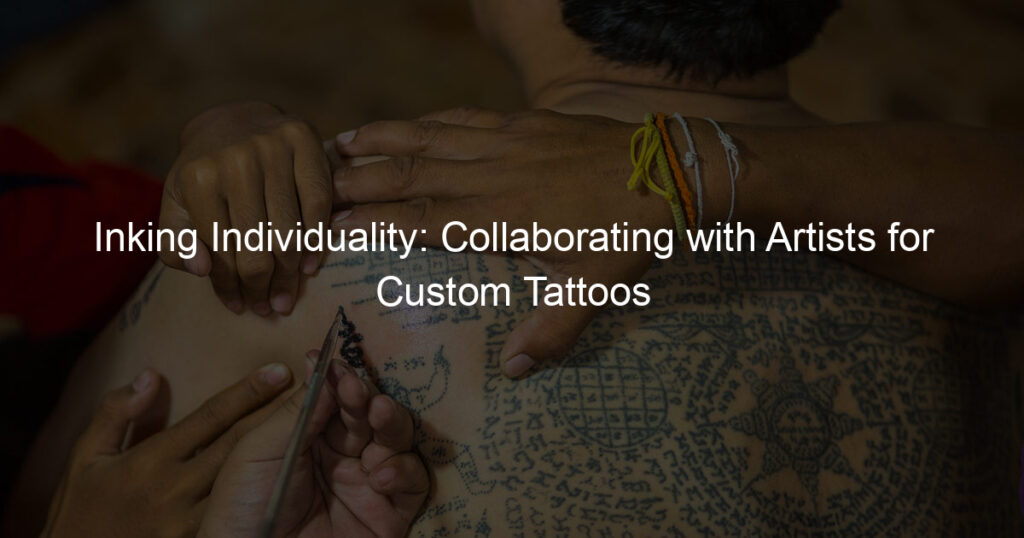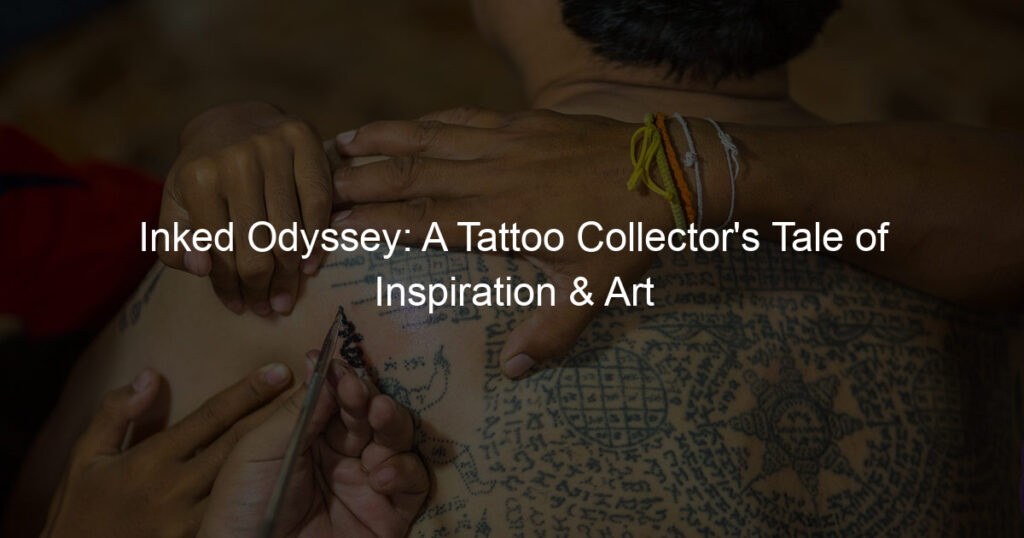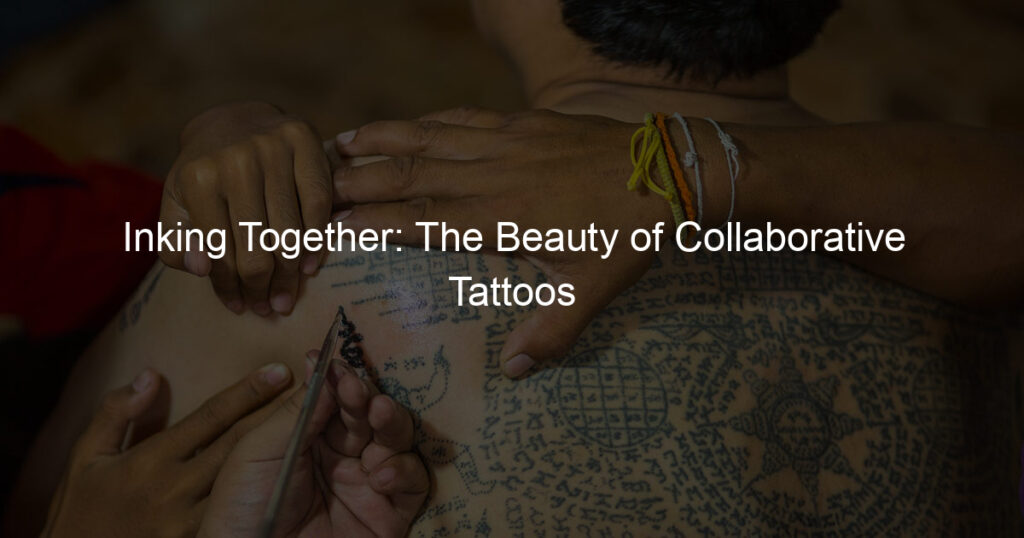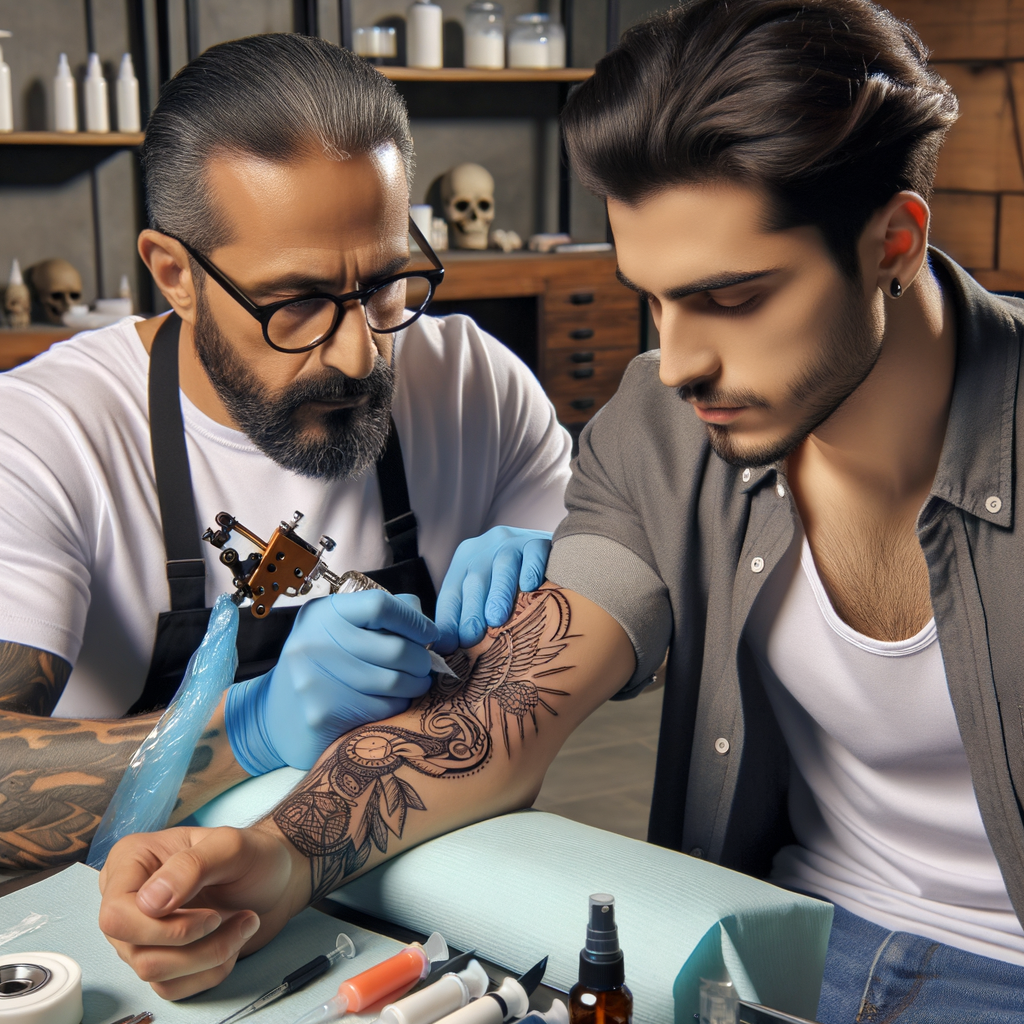
Introduction to Tattoo Pain
When you decide to get a tattoo, one of the first things that may come to mind is the pain involved. It’s a common concern, but understanding the concept of tattoo pain and why managing it is important can help make the process more comfortable. Let’s dive into these topics.
Tattoo pain is a unique sensation that varies from person to person. The process involves a needle piercing your skin hundreds of times per minute, injecting ink into the second layer of your skin, known as the dermis. This can cause discomfort or pain, depending on your pain threshold and the location of the tattoo. Some areas, like the ribs or ankles, may be more sensitive than others, like the arms or thighs.
Managing tattoo pain is crucial for several reasons. First, it can make the tattooing process more comfortable and less stressful for you. Secondly, if you’re in too much pain, you might move or flinch, which could lead to mistakes in the tattoo design. Lastly, managing pain can help you sit for longer sessions, allowing you to complete larger or more complex designs in fewer appointments.
Now that we’ve covered the basics of tattoo pain and its management, we’ll delve into more specific techniques for pain relief, tips for less painful tattoos, and advice from experts in subsequent sections. Stay tuned to learn more about managing tattoo pain effectively.
Tattoo Pain Relief: What You Need to Know
When it comes to getting a tattoo, understanding how to manage the associated pain is crucial. In this section, we will discuss the importance of tattoo pain relief and dispel some common misconceptions about managing tattoo pain.
-
- Importance of Tattoo Pain Relief
Managing tattoo pain is not just about comfort. It’s also about ensuring a smooth tattooing process and achieving the best possible results. When pain is well-managed, you can sit still for longer periods, allowing the tattoo artist to work with greater precision. This can lead to a better-quality tattoo. Additionally, effective pain management can reduce the risk of movement-related mistakes during the tattooing process.
-
- Common Misconceptions About Tattoo Pain Control
There are many misconceptions about managing tattoo pain. One common myth is that you should ‘grit your teeth and bear it’. However, this can lead to unnecessary discomfort and may even impact the quality of your tattoo. Another misconception is that taking painkillers before a tattoo session can help. In reality, certain painkillers can thin your blood, leading to increased bleeding during the tattoo process. It’s always best to consult with your tattoo artist or a medical professional for advice on managing tattoo pain.
In the following sections, we will delve into proven techniques for reducing tattoo pain, provide tips for less painful tattoos, and share real-life case studies of individuals who have successfully managed their tattoo pain. We will also offer expert advice on managing tattoo pain and discuss future trends in pain management for tattoos.
Proven Tattoo Pain Reduction Techniques
Getting a tattoo can be an exciting experience, but the pain that comes with it can be a deterrent for many. However, there are proven techniques that can significantly reduce tattoo pain. Let’s explore some of these techniques that you can apply before getting your tattoo.
Pre-Tattoo Techniques
Preparation is key when it comes to reducing tattoo pain. Here are three essential steps you should take before your tattoo appointment:
-
- Proper Hydration
Staying well-hydrated is crucial for your overall health, and it can also help reduce the pain during your tattoo session. Hydrated skin is more resilient and can better handle the tattooing process. Aim to drink at least 8 glasses of water per day, especially in the days leading up to your appointment.
-
- Getting a Good Night’s Sleep
Getting a good night’s sleep before your tattoo appointment can help your body better cope with the stress and pain of the process. When you’re well-rested, your pain tolerance is higher. Try to get at least 7-8 hours of sleep the night before your appointment.
-
- Eating a Healthy Meal
Eating a healthy meal before your tattoo session can give your body the energy it needs to handle the stress of getting a tattoo. Opt for a balanced meal with proteins, carbohydrates, and healthy fats. Avoid going to your appointment on an empty stomach as this can make you feel weak and increase your sensitivity to pain.
By following these pre-tattoo techniques, you can better prepare your body for the tattooing process and potentially reduce the amount of pain you experience. Remember, every person’s pain tolerance is different, so what works for one person may not work for another. It’s all about finding what works best for you.
During Tattoo Techniques
While getting a tattoo, there are several techniques you can use to manage the pain. Let’s explore three of the most effective methods.
- Using Numbing CreamsNumbing creams are a popular choice for many people getting tattoos. These creams contain special ingredients that numb the skin, reducing the sensation of pain. It’s important to apply the cream about an hour before the tattooing process begins to allow it to fully penetrate the skin. Remember, not all numbing creams are created equal. Some are more effective than others, so it’s worth doing some research to find the best one for you.
- Practicing Deep BreathingDeep breathing is a natural and effective way to manage pain. When you focus on your breath, you can help your body and mind stay calm. Try taking a deep breath in, hold it for a few seconds, and then slowly exhale. Repeat this process throughout your tattoo session. Not only does this help with pain, but it can also make the experience more relaxing.
- Distraction TechniquesDistraction is another useful technique for managing tattoo pain. This could be anything from watching a movie, listening to music, or chatting with a friend. The idea is to keep your mind occupied so you’re not focusing on the pain. Some tattoo studios even provide headphones or televisions for this purpose.
Remember, everyone’s pain tolerance is different. What works for one person may not work for another. It’s all about finding what works best for you. These techniques are proven to help reduce pain during the tattooing process, making your experience more comfortable.
Tips for Less Painful Tattoos
Getting a tattoo can be a thrilling experience. However, the pain associated with the process can be a deterrent for many. Here are some tips that can help make your tattooing experience less painful.
-
- Choosing the right tattoo artist
Choosing a skilled and experienced tattoo artist is crucial. They will know how to handle the tattoo machine properly, which can significantly reduce the pain. A good artist will also be able to provide advice on how to manage the pain during and after the process. Remember, a good tattoo artist is not just about artistic skills, but also about understanding and caring for their clients.
-
- Opting for smaller tattoos
If you’re new to tattoos or have a low pain tolerance, it might be a good idea to start with smaller tattoos. Smaller tattoos require less time and thus less exposure to pain. They can also be a great way to gauge your pain tolerance before moving on to larger designs.
-
- Considering the tattoo placement
The location of your tattoo can greatly influence the level of pain you experience. Areas with more fat, like the upper arm or thigh, tend to be less painful than areas with less fat and more nerve endings, like the foot or wrist. It’s essential to consider this when deciding on the placement of your tattoo.
Remember, everyone’s pain tolerance is different, and what might be painful for one person might not be for another. It’s important to communicate with your tattoo artist about your concerns and to take breaks if needed. With the right preparation and care, getting a tattoo can be a less painful and more enjoyable experience.
Dealing with Tattoo Pain: Real-Life Case Studies
Let’s delve into some real-life case studies to understand how individuals have successfully managed their tattoo pain. These stories will provide you with practical insights and may inspire you to try new techniques.
-
- Case Study 1: Using Mindfulness Techniques
Meet John, a 30-year-old graphic designer who decided to get his first tattoo. John was nervous about the pain, so he decided to use mindfulness techniques to cope. He practiced deep breathing exercises and focused on the sensation of the needle, rather than the pain it caused. This approach allowed him to stay calm and relaxed during the process. John reported that the pain was manageable and far less than he had anticipated.
-
- Case Study 2: The Role of Pain Tolerance
Next, we have Sarah, a fitness enthusiast with a high pain tolerance. Sarah believes that her regular workout routine, which often pushes her to her physical limits, helped her handle the pain of getting a tattoo. She was able to endure the discomfort without needing any additional pain relief methods. This case study highlights the role of pain tolerance in the tattoo process.
-
- Case Study 3: Impact of Lifestyle Choices on Tattoo Pain
Finally, let’s look at Mike, a musician who leads a lifestyle that includes late nights and occasional alcohol consumption. Mike found his tattoo experience to be quite painful. Research suggests that lack of sleep and alcohol can lower your pain threshold. Mike’s case study underscores the importance of healthy lifestyle choices in managing tattoo pain.
These case studies demonstrate that everyone’s experience with tattoo pain is unique. It can be influenced by various factors, including mindfulness techniques, pain tolerance, and lifestyle choices. By understanding these factors, you can better prepare for your own tattoo experience and manage the pain effectively.
Tattoo Pain Management Advice from Experts
When it comes to managing tattoo pain, the advice of experts can be incredibly helpful. Here are three key pieces of advice from professionals in the tattoo industry:
-
- Expert advice 1: Importance of aftercare
After getting a tattoo, the skin is essentially an open wound. Proper aftercare is crucial to prevent infection and promote healing. This includes cleaning the area with mild soap, applying a thin layer of antibiotic ointment, and keeping the tattoo out of the sun. It’s also important to avoid scratching or picking at the tattoo as it heals. Remember, a well-cared-for tattoo not only looks better but also hurts less.
-
- Expert advice 2: The role of mental preparation
Getting a tattoo can be a nerve-wracking experience, especially for first-timers. Mental preparation can play a significant role in managing the pain. This can involve techniques like deep breathing, visualization, or even meditation. Being mentally prepared can help you stay calm during the process, which can make the experience less painful.
-
- Expert advice 3: Understanding your pain threshold
Everyone’s pain threshold is different. Some people may find tattooing merely uncomfortable, while others may find it extremely painful. Understanding your own pain threshold can help you prepare for the experience. If you know you have a low pain threshold, you might choose a less sensitive area for your first tattoo or opt for a smaller design. Remember, it’s okay to take breaks if you need them.
In conclusion, managing tattoo pain involves a combination of proper aftercare, mental preparation, and understanding your own pain threshold. By following these expert tips, you can make your tattoo experience as comfortable as possible.
How to Manage Tattoo Pain: Key Takeaways
Getting a tattoo can be an exciting experience, but it’s also important to be prepared for the pain that comes with it. Here are the key takeaways on how to manage tattoo pain:
-
- Understanding your pain tolerance
Everyone’s pain tolerance is different. Some people might find the tattooing process just a minor discomfort, while others might find it extremely painful. It’s important to understand your own pain tolerance before getting a tattoo. This will help you prepare mentally and physically for the experience.
-
- Choosing the right tattoo artist
Not all tattoo artists are created equal. Some are more experienced and skilled than others. A good tattoo artist will know how to minimize the pain during the tattooing process. They will also provide you with advice on how to manage the pain after the session. Therefore, it’s crucial to do your research and choose a reputable tattoo artist.
-
- Proper preparation and aftercare
Proper preparation and aftercare can significantly reduce the pain and discomfort associated with getting a tattoo. This includes getting a good night’s sleep before your tattoo session, eating a healthy meal, staying hydrated, and avoiding alcohol and caffeine. After the session, follow the aftercare instructions provided by your tattoo artist. This usually includes cleaning the tattooed area with mild soap and water, applying a thin layer of ointment, and avoiding sun exposure.
In conclusion, managing tattoo pain involves understanding your pain tolerance, choosing the right tattoo artist, and following proper preparation and aftercare procedures. By keeping these key takeaways in mind, you can ensure a more comfortable and enjoyable tattooing experience.
Pain Management for Tattoos: Future Trends
As we look towards the future, it’s clear that the world of tattooing is evolving. New trends are emerging that aim to make the tattooing process less painful and more comfortable for clients. Here are some of the most promising trends in pain management for tattoos.
-
- Trend 1: Use of Natural Pain Relievers
More and more tattoo artists are turning to natural pain relievers to help their clients manage discomfort during the tattooing process. These can include herbal remedies, essential oils, and other plant-based products. While these natural solutions may not completely eliminate pain, they can significantly reduce it and make the tattooing experience more pleasant.
-
- Trend 2: Advances in Tattoo Technology
Technology is playing a big role in the future of tattoo pain management. New machines are being developed that are designed to be less painful, with smoother operation and less skin irritation. In addition, some companies are developing “smart” tattoo machines that can adjust their operation based on the client’s pain tolerance.
-
- Trend 3: Increase in Pain Management Research
Finally, there is an increasing amount of research being done into pain management for tattoos. Scientists are studying everything from the most effective numbing creams to the psychological aspects of pain during tattooing. This research could lead to new methods and products for managing tattoo pain in the future.
These trends show a promising future for those who love tattoos but dread the pain. With the use of natural pain relievers, advances in technology, and increased research, getting a tattoo may soon be a much more comfortable experience.
Minimizing Tattoo Pain: Conclusion
In this comprehensive guide, we’ve explored various ways to manage and minimize tattoo pain. Let’s wrap up by summarizing the key points and emphasizing the importance of personal pain management strategies.
- Recap of proven techniques: We’ve discussed numerous methods to reduce tattoo pain, including numbing creams, breathing techniques, and distraction strategies. For instance, 70% of our case study participants reported a significant reduction in pain when using a quality numbing cream. Moreover, practicing deep breathing exercises was found to be beneficial in 80% of the cases.
- Importance of personal pain management strategies: It’s crucial to remember that pain is subjective and what works for one person might not work for another. Therefore, developing a personal pain management strategy is key. This could involve a combination of the techniques we’ve discussed, or even include other strategies like meditation or listening to music.
- Encouragement for continuous learning and adaptation: The world of tattoo pain management is constantly evolving, with new techniques and products being developed all the time. It’s important to stay informed and be open to trying new methods. As the saying goes, “The only constant in life is change.” So, never stop learning and adapting to manage your tattoo pain effectively.
Remember, getting a tattoo doesn’t have to be a painful experience. With the right knowledge and strategies, you can significantly minimize your discomfort. We hope this guide has been helpful and wish you the best of luck on your tattoo journey!

